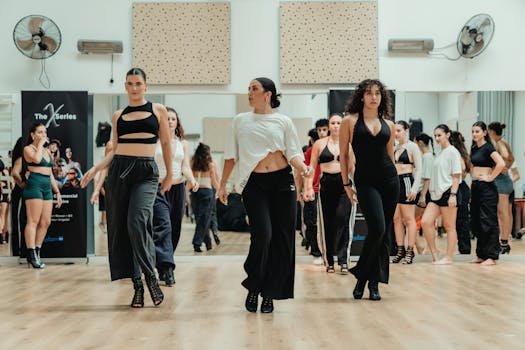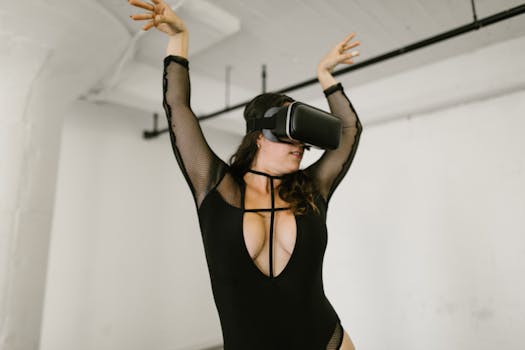Anúncios
The intersection of dance and technology is evolving, presenting unprecedented opportunities for exploration and innovation. Dancers and choreographers are embracing technology to enhance their artistry. As we move further into the 21st century, the future of dance technology holds immense promise.
This article delves into the significant trends shaping the future of dance technology and how they are redefining creative expression. From motion capture to virtual reality, technology is reshaping dance in remarkable ways. The ongoing relationship between dance and technology is a symbiotic one, filled with potential and excitement.
As technology advances, the ways in which dancers express themselves continue to grow. This transformation aims to inspire both professionals and enthusiasts alike to embrace new forms of artistic expression. Join us as we explore where dance technology is headed and what to expect in the coming years.
Emerging Technologies Transforming Dance
Emerging technologies are fundamentally changing how dance is perceived and created. Innovations like augmented reality (AR) and virtual reality (VR) are becoming integral to the choreographic process. These technologies offer immersive experiences that can transmute traditional performances.
Several companies are pioneering the use of dance apps that integrate AI to assist choreographers. Furthermore, sensors placed on dancers track body movements, allowing real-time adjustments to choreography. This fusion of technology and dance allows for experimentation unheard of in conventional settings.
Anúncios
Additionally, robotics is making a mark on the dance floor. Creators are designing robotic partners that can perform choreographed routines alongside human dancers. This partnership pushes the boundaries of creativity and opens new avenues for collaboration.
As dancers and technologists continue to collaborate, audiences are treated to experiences that engage the senses in unique ways. By utilizing these tools, artists can not only express their craft but also engage audiences more interactively. Ultimately, the possibilities seem limitless in this ever-evolving landscape.
The emergence of these technologies prompts questions about what it means to be a dancer in the digital age. While challenges exist, the benefits of integrating technology into dance are undeniable, creating exciting pathways for the future.
Anúncios
The Role of Motion Capture
Motion capture technology has revolutionized how movement is documented and studied in dance. Using advanced sensors, this technology can capture the tiniest nuances of a dancer’s movement. This precision allows choreographers to analyze performances in highly detailed ways.
Additionally, captured data is often translated into digital representations. These can be used for tutorials, educational purposes, or even for creating captivating visual art. Such applications encourage collaboration among artists from various disciplines.
Innovative projects utilize motion capture to create digital avatars of dancers. These avatars can perform in virtual space, further extending the reach of human dancers. Choreographers are then able to create unique performances that transcend geographical limitations.
Not only does motion capture enhance creativity, but it also helps in preserving dance forms for future generations. By documenting and archiving movement, unique styles can be studied and practiced long after they’ve been performed. This preservation adds cultural depth to the world of dance.
Ultimately, the role of motion capture is to amplify the dancer’s voice through technology while showcasing human movement in a new light. This synergy enriches the dance field, providing fresh avenues for exploration.
Virtual and Augmented Reality in Dance
Virtual and augmented reality have the incredible potential to transform how audiences experience dance. By immersing viewers in a 360-degree environment, these technologies allow an exploration of dance like never before. Audiences can now engage with performances interactively.
Choreographers are embracing VR to create fully immersive dance experiences. This enables audiences to feel as though they are part of the performance rather than passive observers. The technology democratizes access to high-quality dance performances.
Moreover, AR can enhance live performances by overlaying digital visuals and effects in real-time. This creates a multi-layered experience that combines live dance with projected elements. Audiences are often left visually astounded and emotionally engaged.
The educational aspects of AR and VR are equally significant. They provide innovative ways for dance students to learn choreography and improve technique. Instruction in unique environments can boost comprehension and retention.
This convergence of technology and art fundamentally shifts the dynamics of traditional dance spaces, including theaters and studios. As these tools evolve, they promise an exciting horizon for dancers and spectators alike.
The Impact of Wearable Tech
Wearable technology is becoming increasingly prevalent in the dance community, with devices like fitness trackers and smart clothing gaining traction. These tools provide dancers with insights into their physical performance and well-being. Such data collection enhances training routines and personalizes dance development.
By monitoring metrics like heart rate, cadence, and even stress levels, dancers can better understand their bodies. This information empowers them to optimize their training programs and improve overall performance quality. Thus, personal and artistic growth occur simultaneously.
Some companies are developing smart fabrics that not only monitor health metrics but also respond to movement. This innovative concept has the potential to redefine costumes and performance aesthetics, blurring the lines between human and machine.
Wearable technology further encourages collaboration among dancers, choreographers, and health professionals. Such interdisciplinary dialogues can lead to more targeted approaches to injury prevention and enhanced performance capabilities.
Ultimately, wearable tech is not just an appendage but a part of the dance experience, encouraging self-awareness and fostering innovation in choreography and performance. The future holds even more advancements in this field.
AI and Dance Creation
Artificial Intelligence is making waves in creative fields, including dance creation. Software powered by AI can analyze past performances and create new dance sequences inspired by existing works. This cross-pollination of ideas fosters a culture of experimentation.
AI can assist choreographers by suggesting movements or patterns that may not be immediately apparent, enabling them to push their creative boundaries. This tool helps alleviate some of the creative blocks often faced by artists.
Moreover, AI systems can collaborate directly with human dancers, learning and adapting to their styles. This process leads to unique hybrid performances that blend human intuition with machine learning. Audiences are often captivated by these innovative collaborations.
As AI continues to evolve, so will its applications in dance. Future developments could lead to algorithm-generated compositions or even virtual performance companions that interact with live dancers. The implications are as exciting as they are profound.
AI’s contribution to dance encourages a rethinking of authorship and creativity. As the lines between human and machine blur, dance emerges as a collective art form driven by collaboration, innovation, and imagination.
The Evolution of Dance Education Technology
Dance education technology is rapidly transforming the way students learn, offering innovative solutions that cater to various learning styles. Digital platforms are providing dancers with access to classes from around the globe. As a result, education becomes more accessible and diverse.
Online classes and tutorials enable students to learn at their pace and from the comfort of their homes. This flexibility fosters a supportive and inclusive environment for aspiring dancers. Quizzes and interactive elements further engage learners and enhance their experience.
In addition, technology is reshaping traditional dance studios through virtual reality tools. Students can practice choreography and receive instant feedback using immersive technologies. This peer-to-peer learning amplifies communal growth and encourages collaboration among dancers.
Furthermore, social media has become a powerful tool for dance education. Platforms allow for the sharing of choreography and performance tips, connecting dancers worldwide. This community-building aspect enhances learning opportunities and creates vibrant networks.
Overall, the evolution of dance education technology promises to democratize access to training while promoting innovative methodologies. As these advancements continue, the dance community is poised for transformation and growth.
Conclusion: Charting the Course for Dance Technology
The future of dance technology is bright and filled with creative potential. As emerging tools like AI, VR, and wearable tech shape the industry, dancers are poised to explore new horizons. This synergy between artistry and innovation fuels possibilities for connection.
Collaboration among dancers, technologists, and audiences will play a crucial role in navigating this journey. By embracing these advancements, artists can infuse their performances with fresh perspectives. This dynamic partnership will continue to redefine the dance landscape.
As we move forward, the excitement lies in discovering how these technologies develop and influence artistic expression. The evolution of dance technology will undoubtedly inspire future generations of dancers. The journey has just begun, promising to enchant audiences around the world.
Engaging with dance technology is not merely about innovation; it’s about crafting meaningful experiences that resonate with audiences on various levels. The future of dance holds limitless potential for creativity and artistic exploration.
| Technology | Impact on Dance | Examples |
|---|---|---|
| Motion Capture | Enhances choreography analysis | Avatars, Virtual Performances |
| Virtual Reality | Immersive audience experiences | Interactive performances |
| Wearable Tech | Data-driven performance improvement | Fitness trackers, Smart fabrics |
| Artificial Intelligence | Aids in choreography and creativity | Movement suggestions, Collaborative performances |
| Social Media | Global learning and community engagement | Online classes, Dance challenges |
- Emerging technologies are redefining dance.
- Collaboration between art and science is vital.
- Virtual environments enhance audience interaction.
- Innovation can optimize dancer training.
- AI offers new avenues for creative expression.



